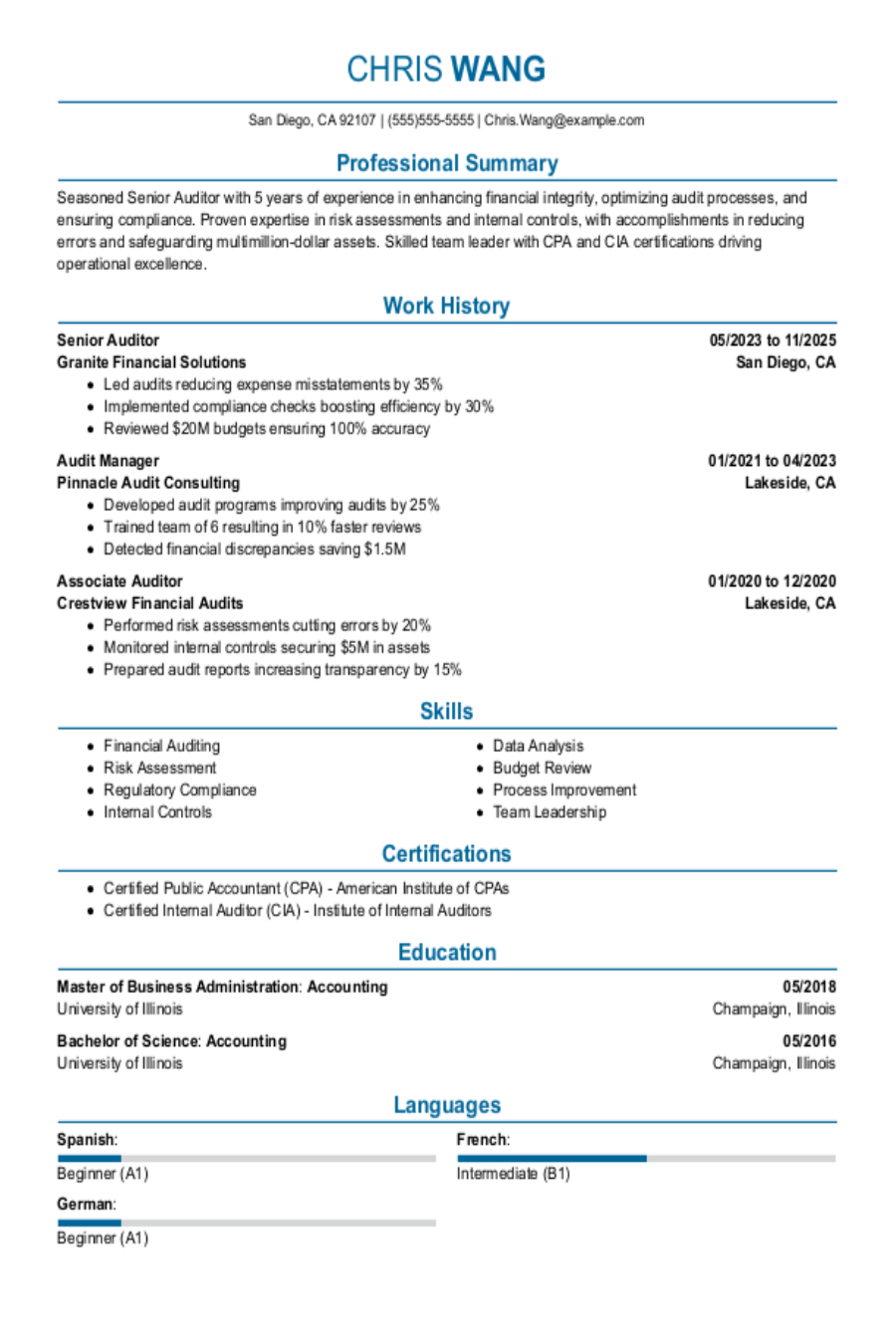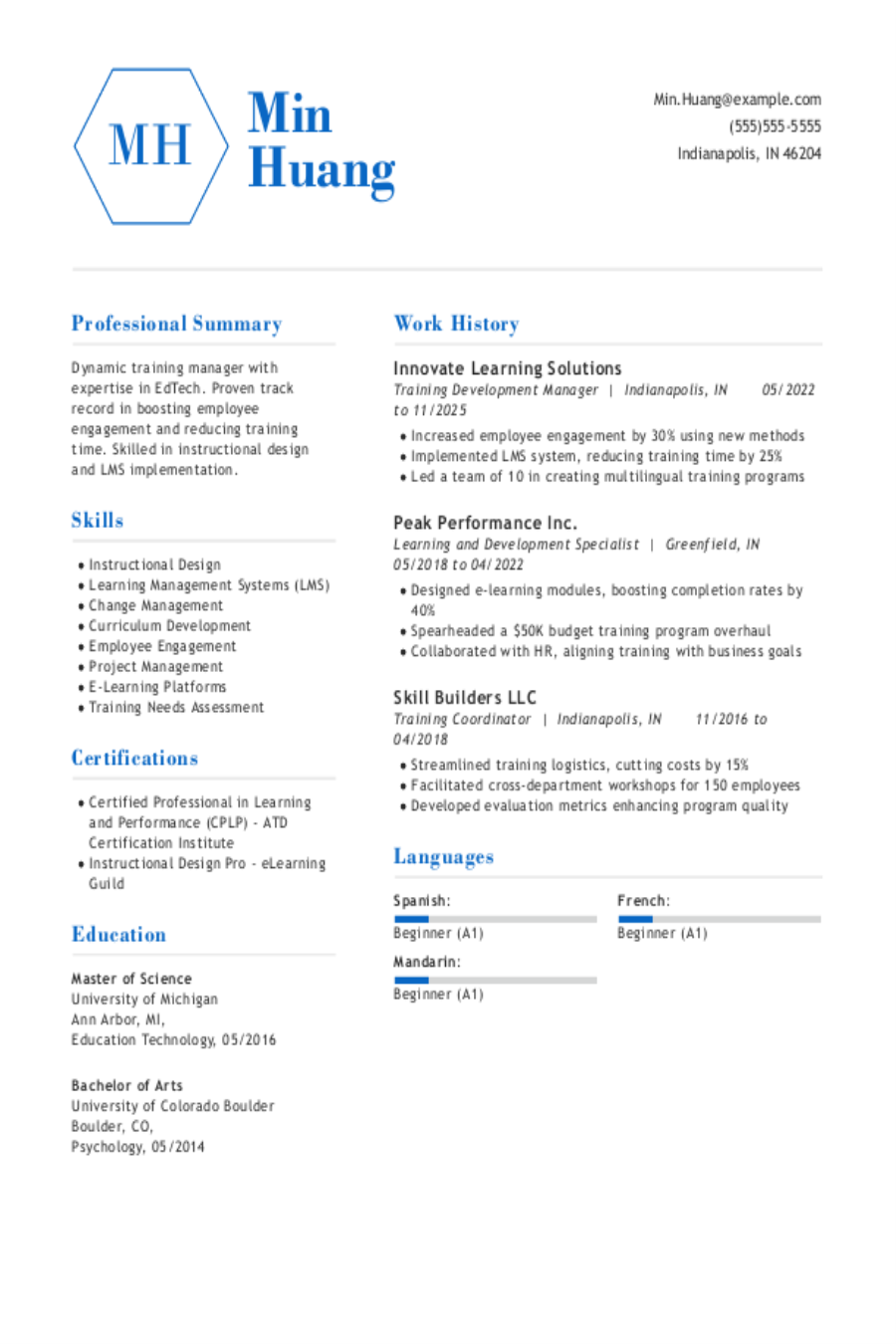Popular Translator Resume Examples
Entry-level translator resume
An entry-level resume for a translator should focus on language skill, relevant coursework, certifications, and any volunteer or freelance work to demonstrate translation skills and cultural understanding.
Focuses on goals: This applicant emphasizes their dedication to improving translation accuracy and project management while actively engaging in professional development through certifications and community involvement.
Prioritizes readability: Choosing a simple resume template improves clarity and streamlines the review process, letting recruiters quickly identify key qualifications without distraction.
Mid-career translator resume
A mid-career translator's resume should emphasize a strong mix of translation experience, language skill, and continuous professional development to effectively demonstrate their value to potential employers.
Includes mix of skills: This resume illustrates a strong combination of technical translation skills and effective interpersonal abilities, showcasing this job seeker’s comprehensive capabilities in the language services field.
Begins with a powerful summary: This resume's professional summary highlights the job seeker's multilingual translation skills and significant achievements, aiding recruiters and ATS in quickly recognizing their relevant qualifications and contributions to global communication projects.
Experienced translator resume
An experienced translator resume should emphasize language skill, relevant project experience, and the ability to convey nuances in meaning across different cultures to highlight professional growth.
Quantifies achievements: Quantifiable achievements, such as translating 500,000 words annually or reducing errors by 25%, provide recruiters with clear evidence of a translator's impact. These metrics improve credibility and make accomplishments easier to recognize and appreciate.
Highlights experience: The resume summary effectively showcases the job seeker's extensive background in translation, emphasizing their dedication to improving accuracy and efficiency.
No experience translator resume
A resume for an applicant with no experience should highlight relevant language skills, any translation coursework, and volunteer projects that showcase the job seeker's ability to communicate effectively across cultures.
Avoids jargon: Job seekers often feel the need to embellish their experience with complex terminology or overblown descriptions of straightforward tasks. Instead, this resume's clear and simple presentation of their skills and responsibilities provides a stronger impact and resonates more effectively with potential employers.
Uses a simple style: The resume's clear layout highlights relevant translation experience and educational background, effectively emphasizing qualifications without unnecessary distractions.
More resume examples
Translator Resume Template
Looking to create a standout application? This translator resume template serves as an excellent foundation—easily personalize it with your details for a polished presentation.
Aya Rodriguez
Miami, FL 33105
(555)555-5555
Aya.Rodriguez@example.com
Professional Summary
Experienced translator with a proven track record in document and live session translation. Bilingual expert with 6 years of experience in linguistic services. Highly skilled in language coordination and multicultural communication, enhancing client satisfaction and retention.
Skills
- Multilingual proficiency
- Translation software expertise
- Strong verbal communication
- Cultural awareness
- Detail-oriented
- Time management
- Creative problem solving
- Project coordination
Work History
Translator
Linguistic Solutions Network - Miami, FL
January 2023 - October 2025
- Translated 200+ documents monthly.
- Reduced translation errors by 15%.
- Improved client satisfaction by 30%.
Interpretation Specialist
Global Words Services - Jacksonville, FL
January 2020 - December 2022
- Interpreted 150 live sessions annually.
- Boosted client retention by 25%.
- Enhanced vocabulary accuracy by 20%.
Language Coordinator
Verbal Experts Ltd. - Tampa, FL
January 2019 - December 2019
- Coordinated 50+ multilingual projects.
- Increased team efficiency by 35%.
- Optimized translation timelines by 40%.
Certifications
- Certified Translator - American Translators Association
- Advanced Interpretation Certification - National Accreditation Authority
Education
Master's Linguistics
University of California, Berkeley Berkeley, CA
June 2018
Bachelor's Modern Languages
University of Michigan Ann Arbor, MI
June 2016
Languages
- Spanish - Beginner (A1)
- French - Beginner (A1)
- German - Intermediate (B1)
Must-Have Skills on a Translator Resume
A robust skills section can significantly improve your resume, showcasing your unique qualifications to potential employers.
Administrative and operational support professionals are the backbone of an efficient workplace. The skills you highlight should demonstrate your ability to keep things running smoothly and strengthen team performance. Your resume is a chance to showcase how you support others and contribute to organizational success.
The following data highlights the most sought-after hard and soft skills relevant to various professions based on Resume Now’s internal resume analytics.
When you’re ready to refine your skills section, explore our AI Resume Skills Generator. It offers tailored suggestions for both hard and soft skills based on your specific job title, helping you create a comprehensive and targeted skill set.
Writing Your Translator Resume
Having explored these compelling resume examples, you're now prepared to dive into the details of how to write a resume. We will walk you through each section step by step, ensuring you create a standout document.
List your most relevant skills
An effective skills section on your translator resume should focus on both the technical skills, such as skill in multiple languages and translation software, and soft skills like cultural awareness and adaptability. This dual focus presents a well-rounded picture of your expertise.
To maximize your impact, carefully read job listings to identify keywords from the job listing that are relevant to the role. Incorporating these keywords into your skills section not only helps human recruiters understand your fit but also ensures you pass through applicant tracking systems. By aligning your skills with the specific requirements outlined in job postings, you improve your chances of standing out as a top applicant.
Example of skills on a translator resume
- Proficient in translating a variety of documents across multiple languages
- Strong understanding of cultural nuances to ensure accurate and context-sensitive translations
- Excellent communicator with the ability to convey complex ideas clearly
- Dedicated to continuous learning and improvement in language skills
A strong skills section should feature both hard and soft skills, showing that an applicant can handle technical tasks while also communicating and working well with others, which is essential for success in any role.
Highlight your work history
Your work experience section allows you to showcase your achievements while demonstrating how you've applied language skills effectively across diverse settings. Highlight specific accomplishments that reflect your expertise, making use of relevant keywords to attract hiring managers.
When detailing each job entry, it's important to include key information such as your job title, employer name, and employment dates. By clearly presenting these details, you establish credibility and help employers quickly evaluate your professional background and experience.
Example of a translator work experience entry
- Translator
Global Language Solutions - San Francisco, CA
January 2021 - Present - Translate over 2,000 pages of legal documents from Spanish to English with a 98% accuracy rate, ensuring compliance with industry standards
- Facilitate communication between clients and stakeholders by providing real-time interpretation services during meetings, improving collaboration and understanding
- Develop glossaries and style guides for specific projects, leading to a 30% reduction in translation turnaround time while maintaining quality
- Mentor junior translators on best practices in localization techniques and cultural nuances, fostering a supportive learning environment within the team
- Consistently receive positive feedback from clients for delivering work ahead of deadlines and exceeding expectations in clarity and tone
Highlighting outcomes and achievements in your experience section is essential because it showcases the direct impact of your work. Employers are more likely to be impressed by specific successes rather than just responsibilities, as this illustrates your ability to deliver results. By demonstrating how you’ve added value, you position yourself as a proactive job seeker who can contribute meaningfully to their team.
Include your education
The education section of your translator resume should list your degrees and certifications in reverse-chronological order, starting with the most recent. Include relevant diplomas while leaving off your high school diploma if you hold a higher degree.
For those currently pursuing further education or with incomplete degrees, it is important to mention your highest completed level along with the expected graduation date. You might also consider including bullet points that outline significant coursework or academic achievements related to language studies.
Common certifications for a translator resume
- Certified Translator (CT) – American Translators Association (ATA)
- Diploma in Translation (DipTrans) – Chartered Institute of Linguists (CIOL)
- Certified Localization Professional (CLP) – Localization Industry Standards Association (LISA)
- Professional Certificate in Translation (PCT) – University of California, San Diego Extension
Showcase publications and research
As a translator, showcasing your publications section on your resume is essential for demonstrating your linguistic expertise and specialized knowledge in various subject areas. Publications highlight not only your skill in languages but also your ability to convey complex ideas accurately and effectively. This adds significant credibility to your profile, especially if you have worked on translations for notable projects or publications.
You should create a dedicated publications section when you have several relevant works to feature, allowing potential employers to easily recognize your contributions. However, if you only have one or two key publications, consider integrating them into sections like education or relevant experience for cohesiveness. Ensure that the citation follows the appropriate style guide based on the context of your work.
Example of a publications section
- Smith, J. & Johnson, A. (2024). "Translation Techniques in Legal Contexts". Journal of Language and Law, 15(1), 22-38.
- Doe, R. & Lee, T. (2023). "Cultural Nuances in Business Translations". International Journal of Translation Studies, 9(2), 101-115.
- Research Contributor, Global Translation Initiative (2022–2023). "Research Contribution on Multilingual Document Processing". Contributed to developing software for improving translation efficiency..
- Chen, H., Johnson, A., et al. (2022). "Collaborative Approaches to Translating Legal Documents". Legal Linguistics Review, 30(4), 175-190.
Sum up your resume with an introduction
Your resume profile is your chance to make a memorable first impression. It's the section that introduces you to potential employers and sets the tone for the rest of your application.
For seasoned professionals, a professional summary is key. This format allows you to present your most significant achievements and qualifications right at the beginning of your resume. If you're early in your career, consider adding a resume objective that showcases your drive for growth.
Professional summary example
Dedicated translator with over 5 years of experience in delivering high-quality translations across various industries. Demonstrated ability to improve communication and understanding through precise language conversion, cultural adaptation, and careful attention to detail. Proficient in both written and spoken translation, ensuring accuracy and fluency in diverse contexts.
Resume objective example
Enthusiastic translator eager to use strong language skill and attention to detail in a collaborative environment. Committed to improving communication and cultural understanding through effective translation, aiming to support diverse client needs while fostering positive relationships.
When crafting your resume profile, start with your job title as a translator. This approach immediately communicates your professional identity and helps employers understand who you are and what you do from the beginning.
Add unique sections to set you apart
Improve your resume with optional sections that highlight your unique qualifications as a translator. These additions can set you apart from other applicants by showcasing specific skills and experiences relevant to the job.
Including sections on hobbies or volunteer work allows you to demonstrate not just your professional abilities but also your personal values. For instance, if you engage in community language programs or participate in cultural exchange activities, it reflects both your passion for languages and commitment to fostering understanding.
Three sections perfect for a translator resume
- Language skill: Demonstrating fluency in multiple languages highlights your ability to communicate effectively in diverse contexts. Include the languages you speak, your skill levels, and any relevant certifications or courses you've completed.
- Translation projects: Listing specific translation projects showcases your practical experience and expertise in handling different types of content. Mention project types, subject matter, and feedback from clients or colleagues where applicable.
- Cultural competency: Your understanding of cultural nuances is important for effective translation. Provide examples of how your cultural knowledge has improved your work or helped bridge communication gaps.
5 Resume Formatting Tips
- Choose a format that matches your career stage.
Selecting the appropriate resume format is important for showcasing your skills. If you have substantial experience, opt for a chronological format to highlight your career progression. For those just starting out, a functional resume can effectively emphasize your abilities and education. A combination format works well if you want to leverage both experiences and skills.
- Pick a smart resume template.
Using a professional resume template can significantly improve the readability of your application. This approach not only makes your content visually appealing but also simplifies formatting tasks. If you opt for a custom layout, ensure it's clean and uses fonts that are compatible with applicant tracking systems to improve your chances of being noticed.
- Select an appropriate font.
Consider using a professional font to improve your resume's readability. Fonts like Garamond, Helvetica, or Verdana are excellent choices that appeal to both ATS systems and hiring managers.
- Use consistent formatting.
Ensure your resume is neatly aligned with uniform margins. This creates a polished look that improves readability and leaves a positive impression on employers.
- Keep your resume to one or two pages.
When crafting your resume, keep in mind that resumes should be one page long. However, a two-page format can be acceptable if you have extensive experience. Focus on keeping your content concise and relevant to showcase your strengths effectively.
What’s the Average Translator Salary?
Translator salaries vary based on location, career level, and qualifications.
This data, provided by the Bureau of Labor Statistics, will show you expected salary ranges for translators in the top 5 highest-paying states, including the District of Columbia. The figures reflect the most current salary data available, collected in 2024.
- Full Range
- Most Common (25th–75th percentile)
- Average
District of Columbia
Most common: $62,930 - $108,970
New York
Most common: $61,240 - $103,880
Maryland
Most common: $55,090 - $110,860
Virginia
Most common: $55,550 - $92,650
Vermont
Most common: $59,380 - $108,130
Tools for Your Job Search
Are you ready to advance in your translation career? Before sending out your application for that dream translator position, make sure to use our ATS Resume Checker. This tool provides essential feedback on how well your resume aligns with the automated systems many companies use during initial screenings.
Improve your resume with our AI Resume Builder, which offers insightful content recommendations specifically designed for your translation expertise. With professional templates, it helps emphasize your linguistic skills and accomplishments, ensuring they captivate hiring managers' attention.
Frequently Asked Questions
Last Updated: October 28, 2025
Absolutely. A cover letter adds invaluable context to your resume, allowing you to communicate directly with potential employers. It’s the perfect opportunity to express your enthusiasm for the translator role and showcase how your unique skills make you an excellent fit. Don’t hesitate—write a cover letter that improves your application.
For a quick and effective solution, consider using our AI Cover Letter Generator. It allows you to create a personalized, job-winning cover letter in just minutes. Plus, you can choose from various cover letter template options that align perfectly with your resume, ensuring a polished and professional presentation of your qualifications.
A resume is typically a concise document, usually one to two pages long, summarizing your skills and work experience. In contrast, a CV (curriculum vitae) can be several pages in length and includes detailed information about your academic achievements, research contributions, publications, and professional history.
You should use a CV when applying for positions in academia or specialized fields such as law and medicine. If you're uncertain about how to create an effective CV, our online CV Maker can assist you in crafting a tailored document quickly. Choose from various CV templates designed for different industries and career levels to get started today.
A frequent mistake translators make is submitting resumes that are not ATS-compatible. To improve your chances, choose a resume template that's ATS-friendly and tailor your resume to reflect the specific skills and requirements mentioned in the job description. This approach improves visibility and aligns your qualifications with employer expectations.
A strong LinkedIn profile is vital for translators seeking job opportunities. It allows you to connect with industry professionals and effectively demonstrate your language skills and expertise.
Many translators begin their careers as language assistants or interns. With experience and additional certifications, they can advance to senior translator roles or specialize in specific fields like legal or medical translation.
Keep your skills sharp as a translator by actively pursuing new certifications and attending workshops. Join translation associations to network with peers, subscribe to industry newsletters, and take online courses that improve your expertise in specific languages or translation technology.
Was this information helpful? Let us know!
Hailey is a career advice writer dedicated to helping job seekers excel in their careers.
More resources

What if I Don't Have Professional References?
Access advice on what to do if you get to the reference check ...
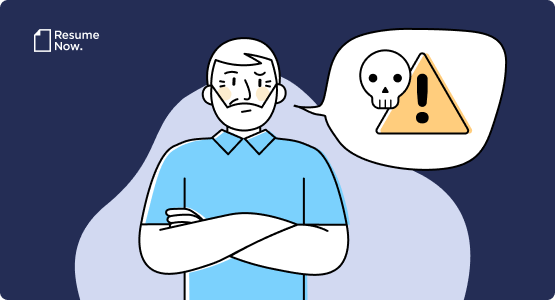
The Most Dangerous Jobs in America: Some Pay Less Than $40K, Others Top $190K
Resume Now s report reveals the highest and lowest paying dang...
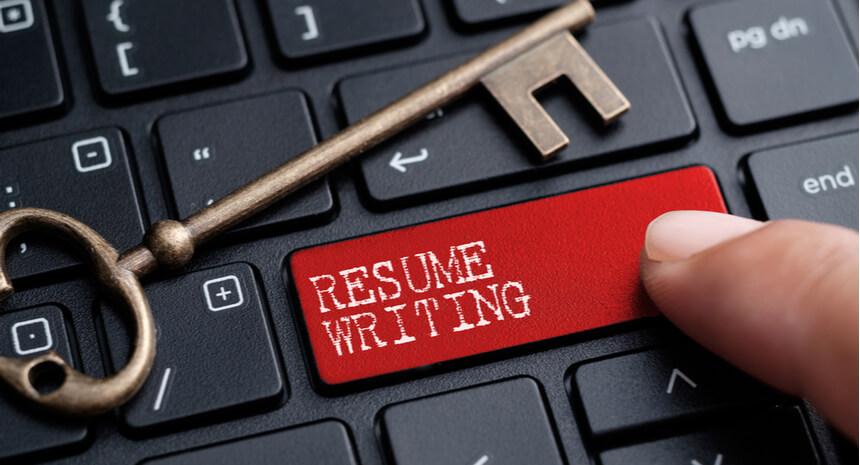
How to Write a Resume: Guide & Examples for 2025
If you re wondering how to write a resume that grabs attenti...
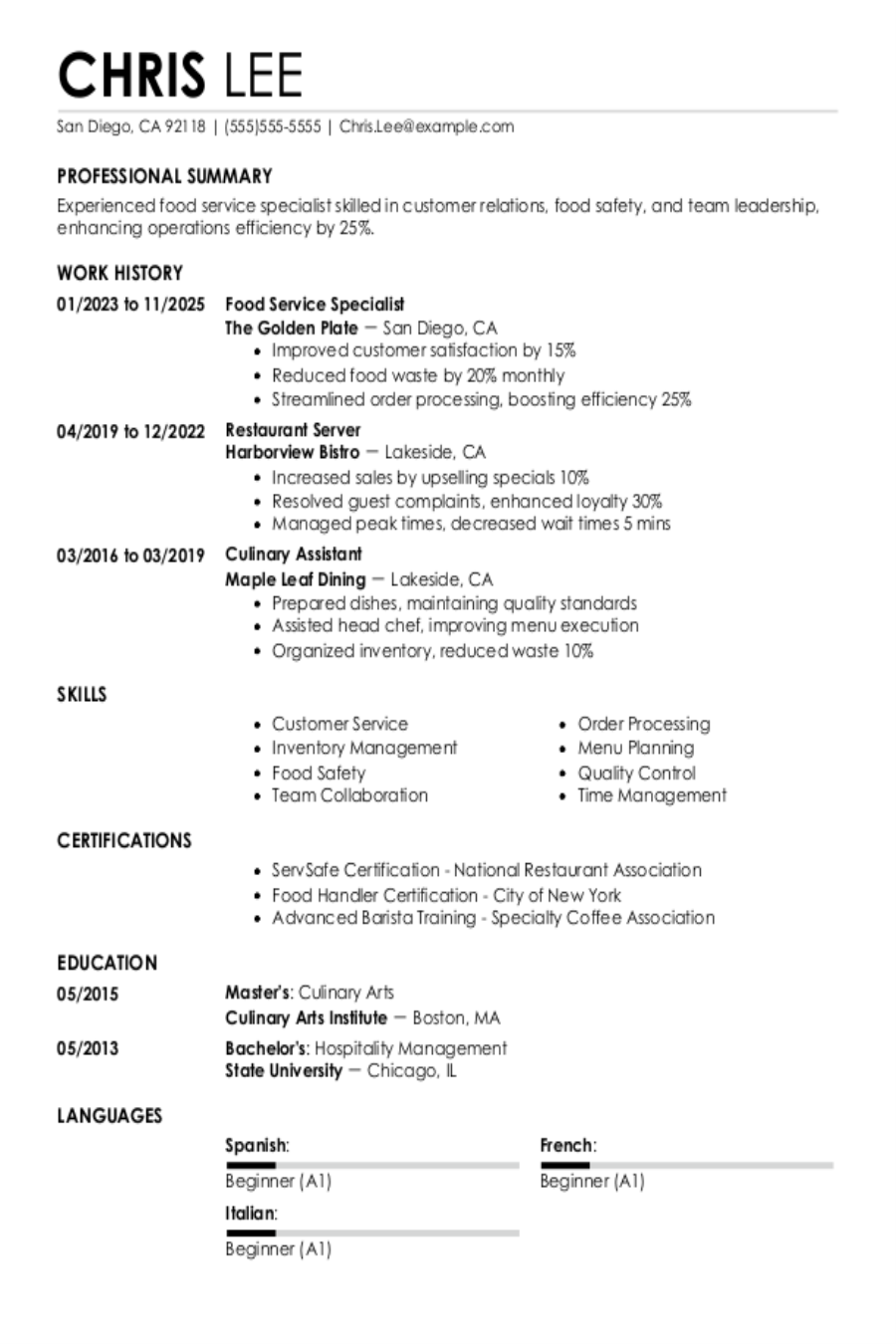
Food Service Resume: Examples, Skills & Template
Looking for work in food service? This guide will help you hig...


